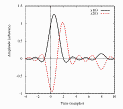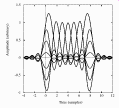
56K Modems
The 56 kbit/s Systems
The last two sections have set out the restrictions of the analogue line, and the possibilities afforded by the new technology. Alone, neither the flexibility of the ISP's digital connection nor the power of DSP-equipped modems will translate into higher speeds over the analogue line. Lucent, Rockwell and US Robotics have had to completely redesign the modem system in order to fully exploit these possibilities.
The designers of the 56 kbit/s modems have called upon entirely different methods to achieve this speed. Whilst the theories they have employed are not new, it has never before been possible to apply them to the telephone system. Each of the following techniques addresses one of the channel's limitations, aiming to avoid or mitigate its effect. Most of them apply only to downstream transfers, for reasons to be explained below.
Inter-Symbol Interference is the first barrier, and a difficult one to overcome. To achieve higher speeds requires an increase in the symbol rate beyond the bandwidth of the channel - ISI is an unavoidable consequence of this. Both products - K56flex and X2 - take this to extremes by using the exchange sampling frequency as the symbol rate: 8,000 symbols/s. At double the channel bandwidth, the severe ISI will threaten to entirely corrupt the transmitted data.
However, designing for no ISI is not the only method. The two products use coding schemes with "controlled" ISI. The conventional premise is that no transmitted bit should interfere with any other, before or after it. Controlled ISI schemes relax this specification: they allow each transmitted bit to interfere with one, and only one, other bit. The coding is designed so that the bit affected by the interference is predictable - the ISI that does occur is controlled by the designer, and compensation can be made for its effect. This technique trades a more efficient use of the channel bandwidth for increased complexity in the receiver, which must decode the partially corrupted data. This is why the availability of cheap, powerful DSPs is important: the coding scheme may be brilliant, but it is useless if the customers cannot afford a modem which uses it.
Both USR and Lucent employ controlled ISI techniques, but they do not use the same coding scheme. This is one of the fundamental incompatibilities between the products. Lucent's coding scheme divides the transmitted data stream into groups of eight symbols. For each group, the ISP modem transmits the first seven symbols but not the eighth. The first seven symbols are shaped so that all the received ISI falls on the time-slot when the eighth symbol should have arrived. Symbols one to seven are therefore free from interference; symbol eight is not worth transmitting, as it would be utterly corrupted and would itself cause ISI.
 Figure 5 shows a plot of the received waveform if only two symbols were to be transmitted. The x axis is time, with the integer scale marking the points where the received signal would be sampled. The y axis is an arbitrary measure of amplitude. Both pulses have been scaled to a value of 1 at the sampling instant, although in reality the amplitude would represent the data for that symbol. Of particular interest are the values of the waveforms at each of the sampling instants. The curve
Figure 5 shows a plot of the received waveform if only two symbols were to be transmitted. The x axis is time, with the integer scale marking the points where the received signal would be sampled. The y axis is an arbitrary measure of amplitude. Both pulses have been scaled to a value of 1 at the sampling instant, although in reality the amplitude would represent the data for that symbol. Of particular interest are the values of the waveforms at each of the sampling instants. The curve y1(t) is only non-zero at two points: samples 1 and 8. Curve y2(t) is only non-zero at samples 2 and 8. The two waveforms represent symbols one and two of the eight-symbol group. Note that neither waveform interferes with the other, but both interfere with sample 8.
 Figure 6 expands this plot to the full seven symbols. Despite the confusion of delayed energy from the multiple symbols, only one waveform is non-zero at the first seven sampling instants. Sample 8 is a complete mess! It would appear that sample 0 is also badly affected: this is because sample 0 is actually sample 8 from the previous symbol group.
Figure 6 expands this plot to the full seven symbols. Despite the confusion of delayed energy from the multiple symbols, only one waveform is non-zero at the first seven sampling instants. Sample 8 is a complete mess! It would appear that sample 0 is also badly affected: this is because sample 0 is actually sample 8 from the previous symbol group.
Taking this coding scheme into account, the maximum data transfer rate may be calculated. The symbol rate is the same as the telephone network's sample rate: 8,000 symbols/s. The exchange switch's Digital to Analogue Converter (DAC) is an 8 bit device, and Lucent's design uses all the available 256 signal amplitudes. If all symbols could be received correctly, the data rate would be
8,000 symbols/s x 8 bit/symbol = 64,000 bit/s.
However, for every eight symbols, only seven can be used. Therefore, the actual maximum data rate is
7/8 x 64,000 bit/s = 56,000 bit/s.
USR's technique is substantially different. It uses every symbol, and does not load all of the ISI onto one sample. Instead, each symbol interferes with one of its neighbours, so that every received symbol is affected by a certain degree of ISI. In order to separate the data from the interference, USR has employed an algorithm known as a Viterbi Equaliser in the receiving modem.
The Viterbi Equaliser works in two stages. Before any data is transferred - on first connection, for example - the two modems analyse the telephone channel's characteristics. To do this, one modem transmits a pre-arranged signal, whilst the other measures the signal it receives. From this can be calculated the frequency response and time delay of the channel. The process is repeated in the opposite direction, and the data fed into the Viterbi algorithm. When real data is then transferred, the Viterbi Equaliser uses its knowledge of the coding scheme and the measured response of the channel to continuously calculate the "most likely" sequence of received data.
This is a similar technique to that used in current modems for error correction. USR is treating the ISI like any other form of noise or interference - something that may cause bit errors, which therefore needs to be countered with a correction algorithm. The Viterbi algorithm is very demanding on processing power, however; once again, a fast DSP is needed.
Back to The Capabilities - Contents - On to Noise Reduction
Main Index - Articles Index
Other interesting websites
 Figure 5 shows a plot of the received waveform if only two symbols were to be transmitted. The x axis is time, with the integer scale marking the points where the received signal would be sampled. The y axis is an arbitrary measure of amplitude. Both pulses have been scaled to a value of 1 at the sampling instant, although in reality the amplitude would represent the data for that symbol. Of particular interest are the values of the waveforms at each of the sampling instants. The curve
Figure 5 shows a plot of the received waveform if only two symbols were to be transmitted. The x axis is time, with the integer scale marking the points where the received signal would be sampled. The y axis is an arbitrary measure of amplitude. Both pulses have been scaled to a value of 1 at the sampling instant, although in reality the amplitude would represent the data for that symbol. Of particular interest are the values of the waveforms at each of the sampling instants. The curve 
